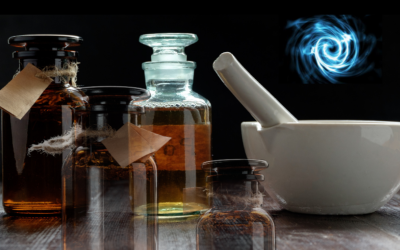Gingergrass essential oil, distilled from the aromatic and herbaceous grass Cymbopogon martini var. sofia, is a close sibling species of Palmarosa (Cymbopogon martini var. motia). In other words, these two oils are oils are distilled from two different varieties of the exact same plant species. Where their natural habitats do overlap spontaneous hybrids of the two sibling species are common.
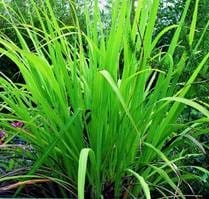
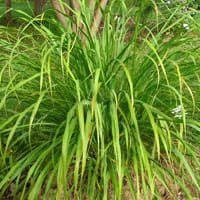
As might be expected, the two oils have very similar profiles regarding their clinical use in both herbal medicine and aromatherapy. However, there are various subtle differences between the two plants. Here are some of these:
- Gingergras is tetraploid and palmarosa is diploid. While a tetraploid organism has four sets of chromosomes, a diploid organism features two sets of chromosomes (one set from the female parent and another set from the male parent).
- The two varieties seldom grow in proximity to each other and are usually found at different altitudes (gingergrass prefers lower altitudes) and in different environments. While palmarosa prefers sunny mountain slopes, forest clearings and dry, well-drained soil, gingergrass is found primarily in humid, low altitude valleys and forests which are well-watered by frequent fog and a high annual rainfall. Thus, while the palmarosa type is better for a dry environment, the gingergrass type is better for one with higher humidity.
- Palmarosa grows in scattered patches in a dry and sunny habitat. Gingergrass grows in dense masses in a wetter and less sunny habitat.
- Gingergrass essential oil has a geraniol content up to 65%. Palmarosa oil has a geraniol content of up to 95%.
- When an inflorescence leaf (an inflorescence is the part of a plant that consists of a flower-bearing stalk or series of branches) of each species is moved from base to tip between ones fingers, while the gingergrass leaf feels rough and sticky, the palmarosa leaf feels smooth and clean.
Spiritual PhytoEssencing (SPE) is not a clinical practice. Rather it employs essential oils for the purpose of deep soul-level healing. All of these differences between gingergrass and palmarosa serve as plant signatures that help highlight differences between the gingergrass- and palmarosa-type individuals (i.e., between individuals who have a deep constitutional affinity for one or the other oil). In this article I will limit my discussion to expanding understanding of the inner nature of these two oils via their gemstone synchronicities.
Synchronicities

Carl Jung coined the term “synchronicity,” referring to thoughts and events that are connected in ways other than causally (i.e., by the law of cause and effect). In Carl Jung: Wounded Healer Of The Soul, Clair Dunne writes: “Jung called synchronicity ‘acausal [without rationally explicable cause] orderedness’, a principle not contradicting the scientific time, space, and causality modes of Western thinking, but rather a complementary addition to it…Synchronicities are hard to verify objectively, but they are subjectively very meaningful.”
In the classic example from his own work, Jung, while listening to a patient recount a dream about a scarab (a type of beetle), heard a light tapping on his office window. When he went to investigate the sound, he saw a brilliantly colored beetle just outside the window. This uncanny coincidence made him wonder about the meaning of such “synchronicities.” In SPE synchronicities play a major role in my elaboration of the unique soul-nature of each essential oil.
Synchronicities, unlike scientifically observed phenomena, cannot be definitively explained via the laws of the space-time dimension. Instead, they emerge from the domain of spirit and collective consciousness. Their value in healing work can only be demonstrated through practical application.
Thus far, I have identified more than 70 synchronicities between specific essential oils and gemstones. These synchronicities play an important role in many of the chapters I have written for Berkowsky’s Synthesis Materia Medica of Essential Oils. Gemstone synchronicities play an especially crucial role in the differentiation between palmarosa oil and gingergrass oil.
Plants, like human beings and all other animals, are alive and everything that is alive is ensouled. In the same way, that one cannot really know another person without developing relation with his or her authentic self (that aspect of the self-structure which has never disengaged from spirit), one cannot truly know an essential oil without developing soul-to-soul relation with its innermost realm. This cannot be achieved solely through study of the biochemical profile and therapeutic actions of an oil as these are archetypal images (tangible manifestations of an underlying non-material archetype) that represent just a fraction of the complex archetypal fabric of the oil.
An essential oil is the most concentrated carrier of the soul of the plant. Thus, to truly know an oil, we must endeavor to reveal to our conscious awareness the unique archetypal pattern within its soul structure. In Spiritual PhytoEssencing, this is accomplished through the identification, and subsequent inter-correlation, of synchronicities including essential oil/gemstone correspondences.
I have been in practice for close to 40 years and gemstones and gemstone elixirs have always been a part of that. My relationship with stones actually began much earlier when I was still in elementary school. In 4th grade I became a serious rock collector and spent many a Sunday afternoon in the gemstone gallery of Manhattan’s American Museum of Natural History. I still have my boyhood rock collection and occasionally use some of those stones in my work.
The process of identifying a particular essential oil/gemstone synchronicity is a complex one that incorporates not just logical thought-driven research but also connection to spirit. The integrated operations of the four windows of knowing (sensing, feeling, thinking and connection to spirit) are required both to sustain cosmic consciousness (higher consciousness associated with the process of connecting one’s inner spiritual self with the entire being of the natural universe) as well as the process of soul embodiment and the ongoing primacy of the real self in everyday consciousness. To be truly effective, any practitioner who aspires to soul-level healing work must ultimately be guided by spirit. This is a complex topic which is beyond the scope of this article. However, I will discuss it during the blending portion of the SPE/NHSS membership program.
Topaz
Both gingergrass and palmarosa have an affinity for topaz in general. However, while gingergrass’ most specific affinity is earthy brown topaz, palmarosa’s is for heart-centered pink topaz.
The word topaz derives from the Sanskrit words nama tapas, meaning fire. The ancient Egyptians held that the topaz gained its color from the golden glow of their sun god Ra. This power was thought to make topaz amulets very powerful protectors against harm. Also, the Romans associated topaz with their sun god, Jupiter. Interestingly, the ultraviolet rays of sunlight displace electrons within the color centers in a topaz crystal and cause it to change color. Despite this alignment with the sun, mystics believe that the gemstone’s protective and curative powers waxed and waned in accordance with the phases of the moon.
In terms of the chakras, topaz specifically helps draw off negativity from, and clear energy blockages in, the solar plexus (3rd), third eye (6th) and crown (7th) chakras. However, it essentially impacts all the activities of all the chakras. Topaz helps one let go of restrictive thought patterns and allow one to become more open, relaxed and amenable to listen to the input of others and to expand one’s perspectives.
Brown Topaz
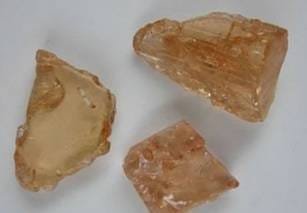

Gingergrass is associated with brown topaz. In general, the color brown, the color of soil, wood and various stones such as sandstone is associated with connection to Earth, nurturing, comfort, fertility, stability, grounding, security, wholesomeness, dependability, orderliness, the feeling of belonging and fitting in, steadfastness, simplicity and sound health.
Brown gemstones in general are associated with the themes of connection to the natural world, centering, grounding, comfort, nurturing, organization, order as opposed to chaos, decisiveness and Earth energy. Brown topaz encourages optimal choices based upon discernment and refinement. In this way, it can help reduces distrust, uncertainty and doubt, especially self-doubt. This gemstone builds inner strength and stability, self-confidence and commitment. It also supports stronger devotion in love and the capacity for developing lasting friendships.
Brown topaz may prove of good service for those who tend to be closed and distrust life. It is thought to have potential value in the treatment of agitation, restlessness, agoraphobia, timidity, and obsessive-compulsive disorder. Via its supports of Chakra 1 (Root chakra), brown topaz increases inner strength, motivation and reduces feelings of insecurity. Sometimes referred to as the “Earth gem” it can provide unique benefit to farmers, gardeners, those who work with animals and conservationists.
Pink Topaz
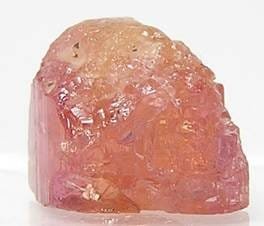

Palmarosa oil is associated with pink topaz. On a psycho-spiritual level pink, the color associated with the energy of kindness and unconditional love pacifies and calms and so can be used to ameliorate anger aggression, irritation, over-sensitivity and feelings of neglect and otherwise promote emotional comfort and healing. As pink has been found to have a tranquilizing effect upon those prone to aggression and violence, it is often the paint color of choice in prisons, mental institutions, hospitals, and drug rehabilitation centers (it may help reduce the anxiety and suffering associated with withdrawal symptoms).
Pink, associated with the Heart chakra and the product of the “marriage” of red and white, can aid in the healing of wounded intimate relationships. It has been observed that those who are drawn to pink are likely to readily display kindness, consideration and forgiveness. Decorators often use pink in bedrooms because it is evokes romantic feelings. Supposedly, the auras of newborn babies and their mothers are suffused with pink and its mother glows in the energy of the pink ray.
Pink encourages the perception of beauty, compassion, love, and purity of intent. Pink, associated with honesty, integrity and openness helps develop the capacity for self-respect and self-love in those individuals who tend to be perfectionists and to be very hard on themselves. When employed as an aid to meditation in can aid in the illumination of higher truths.
The differences between brown topaz and pink topaz can clearly be perceived both via thought-based analysis and feeling. These differences can then be used to help broaden one’s understanding of the qualitative differences between the inner natures of gingergrass and palmarosa oils. In turn, this will aid in the determination of which of these oils is most relevant regarding the soul-nature of a specific individual.
Related Reading
-
Product on sale
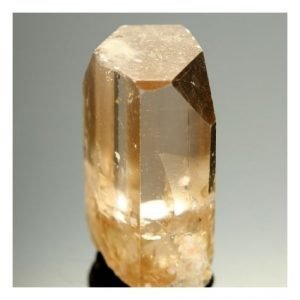 TopazOriginal price was: $30.00.$24.00Current price is: $24.00.
TopazOriginal price was: $30.00.$24.00Current price is: $24.00. -
 Palmarosa Materia Medica$5.00
Palmarosa Materia Medica$5.00 -
 Gingergrass Materia Medica$5.00
Gingergrass Materia Medica$5.00 -
 Berkowsky’s Synthesis Materia Medica/Spiritualis of Essential Oils$385.00
Berkowsky’s Synthesis Materia Medica/Spiritualis of Essential Oils$385.00 -
 2022 Spiritual PhytoEssencing Repertory of Essential Oils$35.00
2022 Spiritual PhytoEssencing Repertory of Essential Oils$35.00




